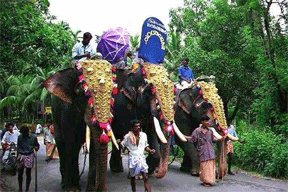Dec 18, 2025
Dec 18, 2025
 India is a land of festivals and festivities. These festivals are basically meant to express gratitude to the forces of nature that help the human beings to produce wealth of food from tilling the land, to procreate and bring to life best offspring, to harness energy resources from water, air, and sun energy. Thus sun, air, water (rivers, seas, and ocean) trees and forest (that give us wood and herbs and roots as medicines) became objects of worship.
India is a land of festivals and festivities. These festivals are basically meant to express gratitude to the forces of nature that help the human beings to produce wealth of food from tilling the land, to procreate and bring to life best offspring, to harness energy resources from water, air, and sun energy. Thus sun, air, water (rivers, seas, and ocean) trees and forest (that give us wood and herbs and roots as medicines) became objects of worship.
Thus festivals became not only the personal, family, and social occasions of fun and merriment, but also prayer and worship of various gods and goddesses.
Thus to supplement this spiritual drive, various functions at family and social level are organized that gave variety and entertainment in life. It was not possible for householders to meditate and worship the Self for whole day. Most people were engaged in some or the other activity to earn their bread. These activities till recent times, before the advent of scientific and technological revolution, were restricted and related to agriculture, food processing and cottage industries. Farmers were supported by carpenters, veterinary specialist, and market men dealing with purchase and sell of farm produce. [Still 70% of India lives in villages.]
Thus social festivals were organized at the beginning and end of farming activities. At the beginning, unsure of vagaries of nature, it used to be mostly prayers and worship of village and personal deity, austerities and simple life. This was to propitiate gods of rains, weather, etc. and to pray to them to shower their grace in the form of good rain fall and saving their crop from pests and other catastrophes.
At the end of harvesting, however, once their prayers were rewarded with bountiful grains, cereals and lentils, maize and oilseeds, their joy knew no bounds. Spontaneously, the young and elderly, men and women, boys and girls, all were jubilant. To express their joy, to express their gratitude to mother earth, to express social solidarity the folks spontaneously organized wonderful festivals at the end of harvesting season. With the sell of produce they had money in their pocket. The profit was enough to send them into rapture of dance and merriment. Drums and trumpets, flutes and sirens filled the air with enthusiasm and gaiety. Feet restless to dance rhythmically to the tune of music. Piety, love, and happiness shone over the faces as contentment and smile.
Baisakhi and Holi in the north-west, Dasera and Diwali in mainland, Pongal and Onam in south, and in north-eastern states of India are common festivals of this kind related with prosperity and fertility.
Baisakhi Festival
To inaugurate the New year and to celebrate the success of farming, April 13th when Sun enters into Aries (Mesha) to augment the new cycle, festival of Baisakhi is celebrated predominantly in North India.
Every village is decorated with banners, garlands of flowers and grain tops. Aroma of sweet and curry dishes fills every house from one street to another. Children and all put on new new clothes, girls and ladies enjoy the silk and fine material in particular. Parties are arranged and family members and friends are invited to celebrate the joy of good harvest. Family deity is worshipped and blessings are showered on young ones. The festival is celebrated with gusto particularly in Punjab. The Sikhs celebrate it with overtones of their own religious reasons as Guru Gobind Singh had established the Khalsa Panth on this day.
In Hindu culture supreme love between Radha and Krishna forms the focus of attention. Plays and dramas, dances and puppet shows are arranged depicting the spiritual level of love. Fairs and bazaars are full of enthusiastic gathering of people from many villages and places.
Muslim and British rule of last few centuries has had its sobering influence these activities. The social aspect was down played, but celebrations were alive at family and personal level all throughout that somewhat difficult period of Indian history.
Of late, with independence in 1947 and subsequent success of 'green revolution' interest and expression of these festivals at social level has again picked up. Hundreds of foreigners visit and participate in such festivals in Rajasthan, Kerala, Gujarat, and north-eastern states. This interaction along with globalization of economy is helping to spread Indian culture and belief systems all over the world.
We invite people from various countries to visit us, to study and enjoy these phenomena which are as ancient as history of India itself. The spiritual, moral, and social upliftment through such festivals is good for humanity to foster bonds of brotherhood, friendship, and solidarity.
31-Mar-2000
More by : Dr. C.S. Shah

|
sir..mam 18 october 2015 nice ............ but can you please make a paragraph or poem of only 5 to 6 lines with all information of fistevals of india............. please send it to me personally on my emali id on gimal ............ thanx |

|
your articles is very good , nice, lovely , excellent |

|
India is great...m feeling proud that i m an indian |